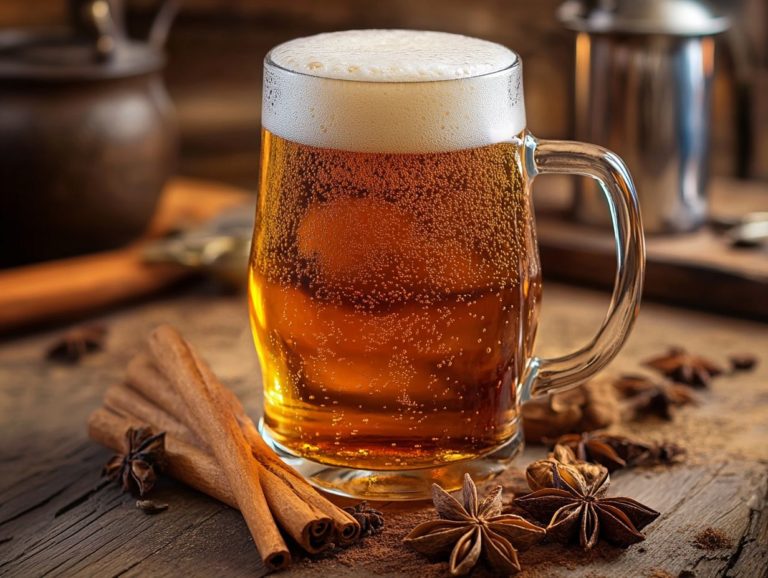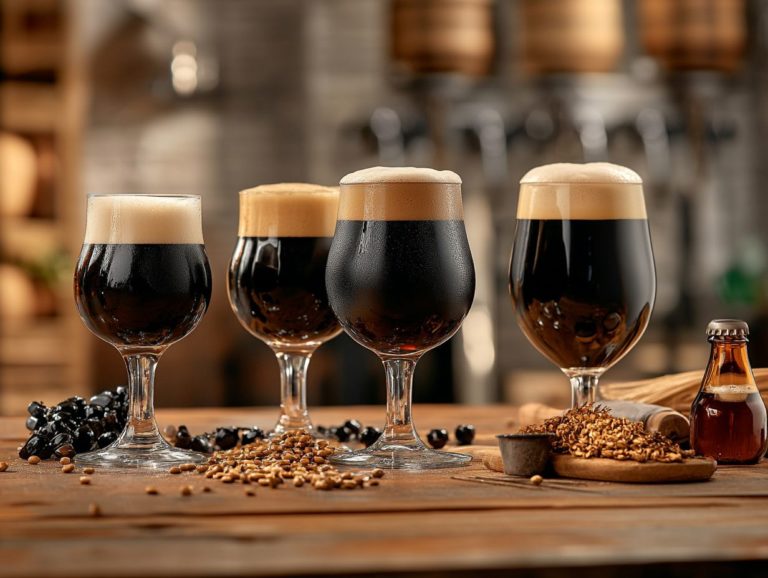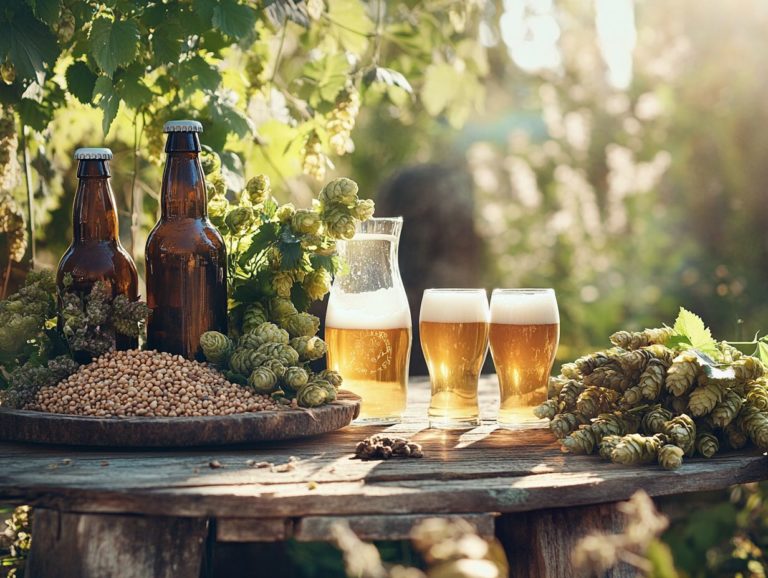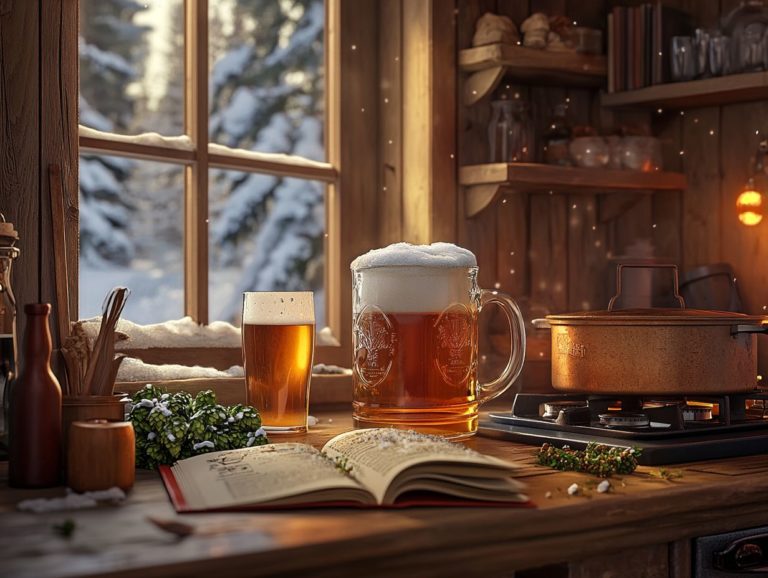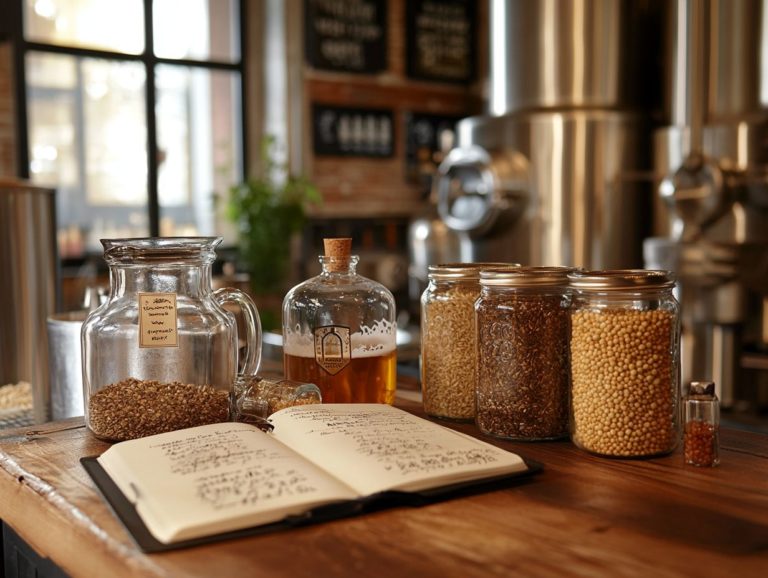How to Perfect Your Homebrew Porter Recipe
Contents
- Perfecting Your Homebrew Porter Recipe
- Key Takeaways:
- What Makes a Good Porter Beer? Exploring the History and Characteristics
- What are the Key Characteristics of a Good Porter Beer? Understanding Ingredients and Brewing Techniques
- How to Create Your Own Homebrew Porter Recipe
- Tips for Perfecting Your Porter Recipe
- 1. Experiment with Different Malts and Hops
- 2. Consider Adding Adjuncts for Added Flavor
- 3. Don’t Be Afraid to Adjust Your Recipe
- 4. Pay Attention to Fermentation Temperature and Time
- 5. Keep Detailed Notes for Brewing Success
- Frequently Asked Questions
- What is a homebrew porter recipe?
- What are the key ingredients in a homebrew porter recipe?
- Do I need any special equipment to make a homebrew porter recipe?
- How can I perfect my homebrew porter recipe?
- How long does it take to make a homebrew porter?
- Can I customize a homebrew porter recipe to my own taste?
Perfecting Your Homebrew Porter Recipe
Porter beer, with its rich flavors and inviting aromas, has captivated craft beer enthusiasts for centuries. But what truly sets a remarkable porter apart from the rest?
This article delves into the various styles of porter, highlighting essential characteristics to seek out, and provides invaluable tips for crafting your own perfect brew at home. Whether you’re just starting out or already have some brewing experience under your belt, you re in for a treat as you discover insights and techniques that will elevate your porter-making skills. Get ready to unleash your creativity and savor the delicious results!
Key Takeaways:
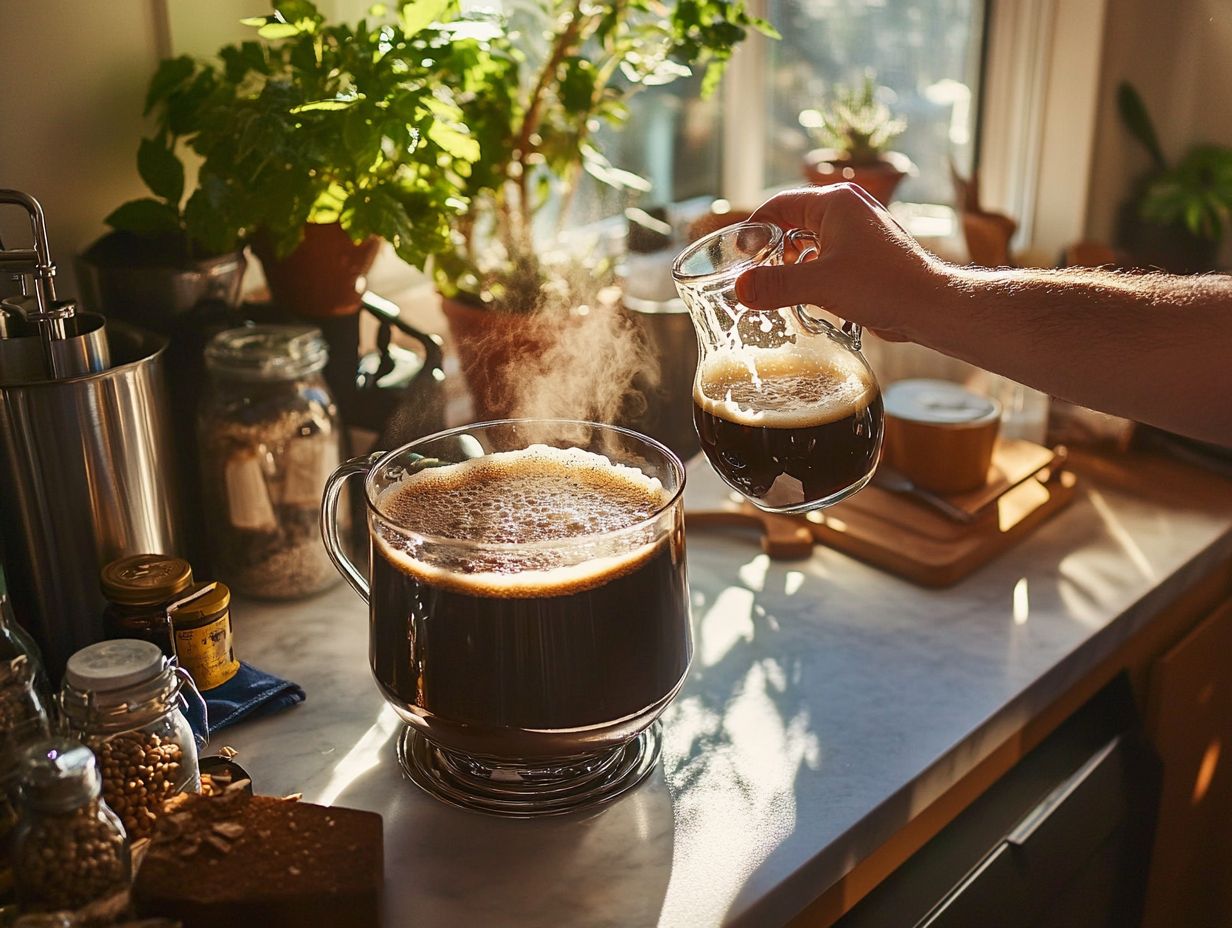
Experiment with different malts and hops. Find the perfect flavor for your homebrew porter!
Add ingredients like chocolate or coffee to enhance complexity. Your porter will stand out!
Adjust your recipe based on taste. Feedback can guide you to perfection!
What Makes a Good Porter Beer? Exploring the History and Characteristics
A fine porter beer captivates you with its rich, complex flavor profile, showcasing the artistry behind the brewing process. It masterfully blends dark malts, hops, and yeast to deliver a robust and satisfying experience.
Originating in 18th-century London, porter has transformed into a cherished beer style, especially within the American craft brewing scene. Here, homebrewers delight in experimenting with recipes that strike a balance between the sweetness of caramel and chocolate malt and a subtle bitterness from hops. This makes it a perennial favorite among discerning beer enthusiasts. Breweries like Guinness and Samuel Smith have historically contributed to its popularity.
What are the Different Styles of Porter Beer?
Porter beer presents you with a diverse range of styles, each boasting its own unique flavor profiles and characteristics. It often finds itself compared to stout, another robust beer style that shares historical roots with porter, yet varies ever so slightly in ingredients and taste.
Traditional English porters, for example, lean towards a milder flavor and a smoother mouthfeel. In contrast, American craft brewing has introduced innovative variations that infuse porters with various additional ingredients and flavors, creating a bold drinking experience tailored to modern palates. The use of ingredients like Fuggle and East Kent Goldings hops is common in these variations.
Among traditional options, the robust porter truly stands out, showcasing deep chocolate and coffee notes, often crafted by iconic breweries like Fuller s and Samuel Smith s. On the other hand, American craft breweries such as Founders and Stone Brewing take things up a notch with their imperial porters, amplifying the alcohol content and introducing complexity through ingredients like cacao, vanilla, and even whiskey barrel aging.
If you re in the mood for something a bit out of the ordinary, flavored porters offer exciting twists. Take Left Hand Brewing Co.’s Peanut Butter Milk Porter, for instance; it masterfully combines rich peanut butter flavors with a creamy finish, highlighting just how versatile this beer style can be.
What are the Key Characteristics of a Good Porter Beer? Understanding Ingredients and Brewing Techniques
Key characteristics of a good porter beer include a complex flavor profile. This profile artfully harmonizes malted sweetness, subtle bitterness, and a smooth mouthfeel, all enhanced by your careful selection of ingredients and brewing techniques.
A successful porter strikes a perfect balance between the richness of dark malts and the lightness of hops, yielding a drink that is both satisfying and refreshing.
Proper fermentation and carbonation processes ensure an inviting texture and aroma, elevating your overall tasting experience.
The interplay between the ingredients is crucial. For instance, when you use high-quality specialty malts, they impart distinct chocolate, coffee, or caramel notes that elevate the drink to new heights. Hops, though used sparingly, provide just enough bitterness to counterbalance the sweetness while also adding floral or earthy undertones.
Yeast plays a pivotal role as well, contributing subtle fruity esters that round out the flavor beautifully.
Learning brewing techniques, such as temperature control during fermentation and allowing for adequate conditioning time, can significantly refine the beer’s mouthfeel and aftertaste. This results in a porter that is truly remarkable and unforgettable. For instance, maintaining proper mash temperature and balancing carbon dioxide levels can elevate the overall quality.
How to Create Your Own Homebrew Porter Recipe
Creating your own homebrew porter is an exhilarating adventure that invites you to explore the exciting world of brewing. You’ll have the opportunity to experiment with a variety of ingredients, including:
- Grains
- Hops
- Yeast
Ultimately, you ll create a distinctive beer that embodies your personal taste.
By familiarizing yourself with the brewing process and recognizing the importance of each ingredient from selecting the right dark malts to meticulously managing fermentation temperatures you can develop a robust porter that showcases the rich flavors and aromas that define this cherished beer style. Remember, the quality of water used also plays a crucial role in the final outcome.
Step 1: Choose Your Base Malt
The first step in crafting your homebrew porter recipe is to select a suitable base malt, as it serves as the backbone of your beer’s flavor and body. Traditionally, porters rely on rich malts such as Pale Malt, Amber Malt, or even specialty grains to add depth and complexity.
Your choice of base malt will significantly influence the overall profile of your porter, providing essential sugars for fermentation while also contributing to its color and taste. Some brewers also use malt extract for added convenience.
Each type of base malt brings its own unique characteristics to your brew. For example, Pale Malt offers a mild, biscuit-like flavor that creates an excellent foundation, whereas Amber Malt imparts a deeper caramel sweetness and a reddish hue, enhancing the visual appeal of your beer.
Specialty grains like Munich or Crystal can elevate your porter even further by adding notes of nuttiness or fruitiness, resulting in a fuller, more satisfying body.
Quality is key when it comes to malt; fresher grains will provide better flavor extraction and fermentable sugars. Be sure to perform a proper mash to optimize enzyme activity, allowing for greater efficiency in sugar conversion.
Don’t miss out on the chance to create a beer that truly reflects your taste!
Step 2: Select Specialty Malts
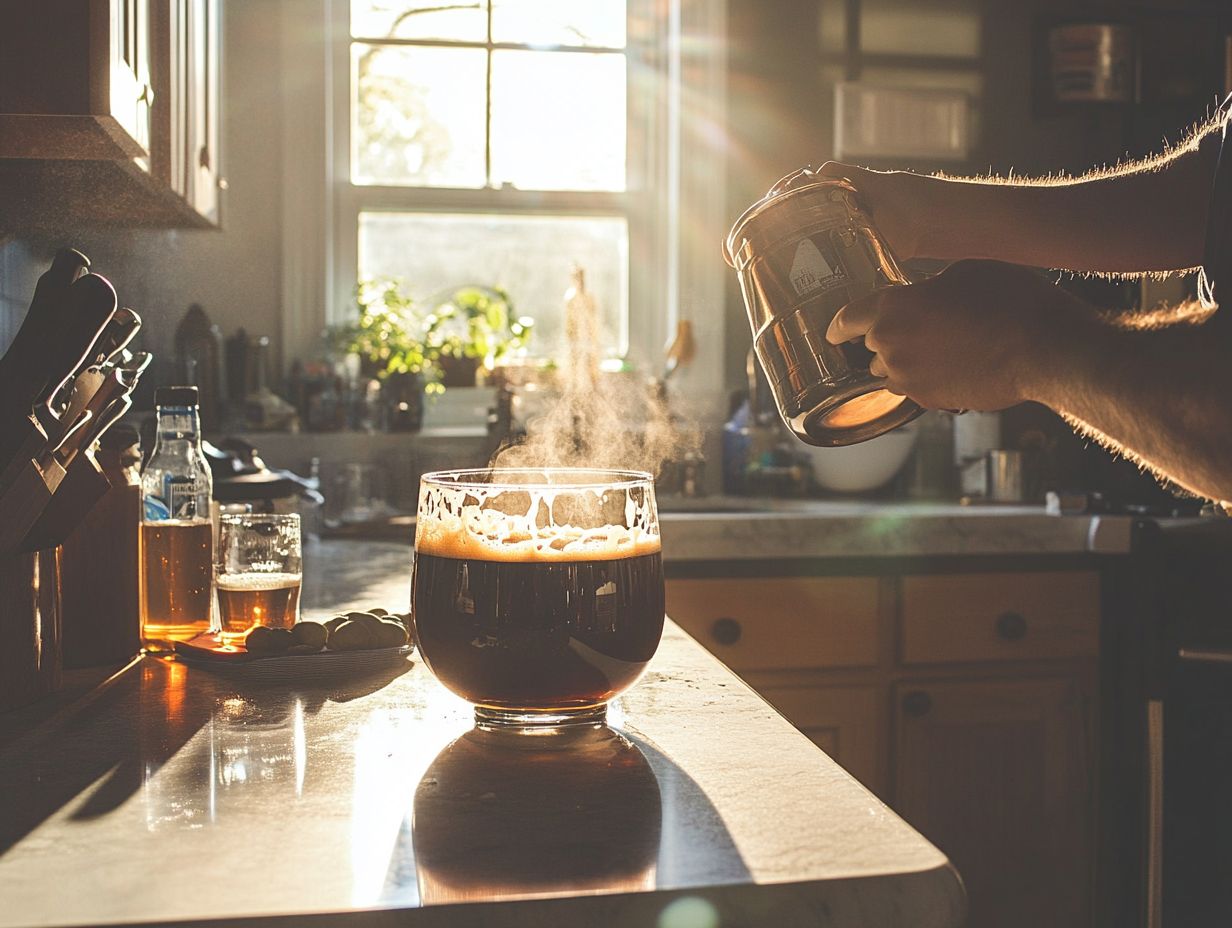
Selecting specialty malts is key to enhancing your homebrew porter s flavor profile. These malts bring unique traits like sweetness and roasted notes.
Dark malts such as Chocolate Malt, Black Patent Malt, and Brown Malt add complexity and depth. They contribute to the signature robust flavor that porters are known for.
Breweries like Timothy Taylor and Wyeast Labs often use these malts in their recipes.
Adding Crystal Malt introduces a delightful caramel sweetness that beautifully balances dark chocolate tones. Munich Malt adds a subtle breadiness to enhance the malt backbone of your brew.
Meanwhile, Roasted Barley, a staple in traditional porters, offers intense coffee-like and burnt flavors that require careful balancing with sweetness from other malts.
As you choose your specialty malts, consider the final color and mouthfeel you desire; these elements can significantly impact your beer’s overall perception.
Don t hesitate to experiment with different combinations. This exploration allows you to craft unique interpretations of the porter style. You might discover a new seasonal brew that becomes a must-have in your collection!
Step 3: Determine Your Hop Schedule
Determining your hop schedule is crucial for brewing a balanced porter. While hops may not take center stage in porters, they are critical for crafting a rich tapestry of flavor and achieving the perfect balance of sweetness and bitterness.
When selecting hops, consider varieties like East Kent Goldings or Fuggle. Their timing during brewing can significantly elevate the aroma and complexity of your porter.
Varieties like Northdown and Willamette also work well in porters.
As a brewer, explore the characteristics of different hop varieties to attain that delicate equilibrium. Noble hops are often preferred for their earthy and floral notes, which beautifully complement the robust malt profile in many porter styles.
By adding hops at various stages such as during the boil for bitterness or in the dry hopping phase for aroma you can significantly influence the final flavor of your brew.
A thoughtfully crafted hop schedule accentuates the malt’s sweetness while ensuring a satisfying finish. This makes every sip of your porter a cohesive and delightful experience. For example, Columbus Hops can add a unique bitterness that complements the malt profile.
Step 4: Add Other Flavorings (Optional)
In this step, consider adding additional ingredients or flavorings to your porter for a unique twist. Ingredients like coffee, chocolate, vanilla, or spices can enhance its complexity and provide a customized taste experience that sets your brew apart.
By experimenting with these additions, you can transform a traditional porter into something exceptional that aligns with your personal preferences. Some brewers even incorporate flavors reminiscent of porterhouse steak for a savory twist.
For instance, incorporating roasted coffee beans imparts a rich coffee aroma and a vibrant flavor profile. Meanwhile, chocolate malt or cacao nibs can amplify those deep, indulgent notes, creating a luxurious mouthfeel.
Vanilla beans bring a delightful sweetness that pairs beautifully with roasted malts. Additionally, spices like cinnamon or nutmeg introduce inviting, wintry undertones.
When blending these flavors, start with small quantities and gradually increase until you find the perfect balance. This ensures that the rich essence of the base porter shines through without being overwhelmed.
By thoughtfully selecting and balancing these ingredients, you can craft a unique signature porter that truly reflects your flavor ideals.
Step 5: Choosing Your Yeast Strain
Choosing the right yeast strain is essential to your fermentation process when crafting that perfect homebrew porter. Different strains can impart unique flavors, aromas, and efficiency in alcohol production, meaning they directly impact your final product.
For instance, popular yeast strains like Wyeast Labs’ English Ale yeast are known for enhancing the malt character and complexity of the beer, resulting in a well-rounded flavor profile. If you re looking for something a bit different, consider White Labs’ WLP005. This strain offers a slightly cleaner finish, allowing the delightful chocolate and roasted malt flavors to take center stage.
On the other hand, if you’re in the mood for a fruity twist, Wyeast 1028 (London Ale) is a fantastic option that introduces pleasant esters, enriching your sensory experience. Keep in mind that each yeast strain behaves differently depending on fermentation temperatures.
Generally, a range of 64 F to 72 F optimizes yeast performance, allowing for a well-balanced fermentation. Extending the fermentation duration can further enhance your beer’s characteristics, ensuring those rich caramel and coffee notes truly shine through. With this effort, you ll create a porter that will amaze your taste buds!
Step 6: Calculating Your Grain Bill and Mash Schedule
Calculating your grain bill and establishing a mash schedule is crucial for achieving the desired gravity and flavor profile of your homebrew porter. This process involves determining the proportions of each malt you’ll use and the specific temperature at which you will mash them.
By meticulously planning these variables, you can optimize sugar extraction and create a solid foundation for the fermentation stage. For example, starting with a base malt like Pale Malt and layering in specialty malts such as roasted barley or crystal malt can help you craft a rich and complex flavor.
The mash schedule typically involves resting at around 152 F (67 C) for about 60 minutes, allowing enzymes to effectively convert starches into sugars. This temperature is key to producing fermentable sugars sugars that yeast can convert into alcohol during fermentation which will significantly influence the final alcohol content and mouthfeel of your beer.
On the flip side, higher temperatures might yield less fermentable sugars, resulting in a fuller-bodied beer. Understanding these dynamics is essential, as they have a profound impact on both the strength and character of your porter.
Tips for Perfecting Your Porter Recipe
Perfecting your porter recipe is a delightful journey that marries science with artistry, demanding your careful attention to brewing tips that can elevate your creation to extraordinary levels. By diving into the nuances of flavor, ingredients, and techniques, you have the opportunity to craft a standout porter that truly embodies your passion for craft brewing.
As you experiment with various malts, hops, or adjuncts, embracing the art of adjustment and refinement will enhance your brewing experience and result in a beer that you can genuinely take pride in. Start experimenting with malts and hops today to discover your signature porter!
1. Experiment with Different Malts and Hops
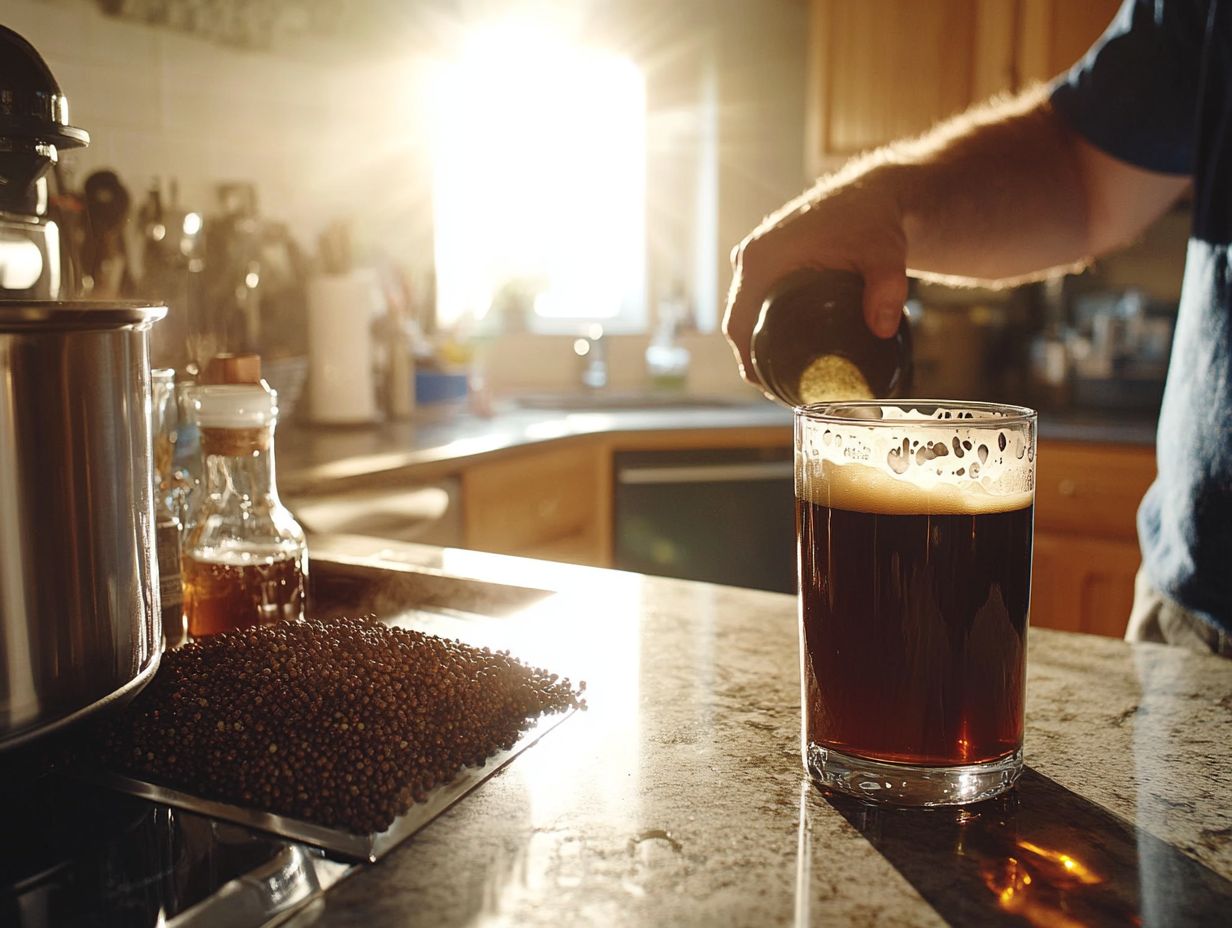
Experimenting with different malts and hops is your key strategy for crafting a unique and flavorful porter. By varying the types and combinations of grains and hops, you can influence the final taste, aroma, and mouthfeel of your beer. This approach opens the door to distinct flavor profiles that cater to a wide range of preferences, ultimately enhancing the drinking experience.
To truly master this art, you’ll need to carefully balance the sweetness of caramel or chocolate malts with the bitterness of hops, creating a harmonious blend that delights the palate. For example, incorporating a rich Munich malt alongside citrusy hops can produce a well-rounded porter with a delightful twist.
Consistency in your brewing method is essential, as even minor variations can significantly affect the outcome. Successful brewers often document their experiments, carefully noting the results of blending roasted barley with floral hops, resulting in standout brews that resonate with both novices and aficionados alike.
2. Consider Adding Adjuncts for Added Flavor
Considering adjuncts for added flavor can lead to exciting variations that showcase your brewing creativity. Ingredients like coffee, spices, or fruits introduce intriguing dimensions that enhance the beer’s core profile.
By thoughtfully selecting adjuncts, you have the opportunity to craft a porter that surprises and delights the palate. This approach appeals to both traditionalists and modern enthusiasts.
Understanding how different adjuncts interact with the rich, malty backbone typical of porters is crucial for achieving a harmonious brew. For instance, incorporating roasted coffee can elevate those delightful chocolate notes.
Spices such as cinnamon or nutmeg can infuse warmth and complexity. To maintain balance, it’s wise to start with small quantities and gradually increase them, allowing time for maturation.
Experimenting with fruit purees or zests can add a bright touch to the beer. However, be mindful that these components should not overshadow the beer s inherent characteristics.
Being transparent in labeling your adjunct choices educates consumers and greatly enhances their tasting experience. Start experimenting today and see how small changes can lead to incredible flavors!
3. Don’t Be Afraid to Adjust Your Recipe
Don t hesitate to adjust your recipe during the brewing process; flexibility can result in improvements that truly enhance the quality and flavor of your porter. Whether it s tweaking the hop schedule or altering malt proportions, being open to adjustments can lead you to discover new and delightful flavors.
This mindset, embraced by many seasoned brewers, invites creativity and allows for brews better tailored to your preferences. For instance, a simple change in hop variety might unveil unexpected aromatic profiles.
Experienced brewers often emphasize that adjusting mash temperatures can significantly impact how well the ingredients can change into alcohol and, in turn, the final taste of the beer. Recognizing that even the slightest alteration can lead to substantial improvements cultivates your brewing skills.
By maintaining an open mind and being willing to adapt on the fly, you can continuously refine your techniques and achieve remarkable results. Capture the essence of innovation in every batch!
4. Pay Attention to Fermentation Temperature and Time
Mastering fermentation temperature and time will unlock the amazing flavors in your porter. By creating the right conditions, you can enhance yeast performance, allowing the character of the beer to develop precisely as you envision.
A stable fermentation environment not only helps prevent unwanted tastes that can spoil your beer but also contributes to a clean and well-rounded final product.
The fermentation temperature plays a critical role in yeast activity. It directly impacts the production of esters and phenols that introduce unique flavors to your brew.
Ale yeast typically flourishes within a temperature range of 65-75 F, making it the perfect choice for many porters. On the other hand, lager yeast prefers cooler surroundings around 45-55 F for a cleaner taste profile.
The duration of fermentation is equally vital; a longer fermentation can help mellow out harsher flavors, whereas a shorter one may result in a more pronounced yeast character.
By carefully monitoring these crucial parameters, you ensure a superior product and create opportunities for experimentation. Fine-tune each batch for optimal taste and quality!
5. Keep Detailed Notes for Brewing Success
Taking detailed notes during your brewing process is crucial for refining your porter recipe over time. By recording specific measurements and ingredients used, you enable yourself to replicate successful batches and learn from any missteps. This practice helps you stay consistent and improve your brewing knowledge.
By meticulously documenting each stage from selecting the grains to monitoring fermentation temperatures (the temperature at which yeast ferments the sugars into alcohol) you can discover what works best under various conditions. Your brewing can skyrocket with a keen eye for detail. To effectively organize your notes, consider creating a detailed brewing notebook or a digital log where each session is clearly dated and categorized.
Using bullet points or tables makes your notes easier to access and comprehend when you reference past techniques. This is especially helpful when comparing different brewing methods or adjusting mash temperatures.
Incorporating elements like tasting notes or even photographs can significantly enhance the richness of your documented experience. Including details about the flavor profile or carbonation levels can also be beneficial. A well-maintained brewing journal becomes a valuable resource, guiding you toward achieving that perfect porter with every new attempt.
Frequently Asked Questions
What is a homebrew porter recipe?
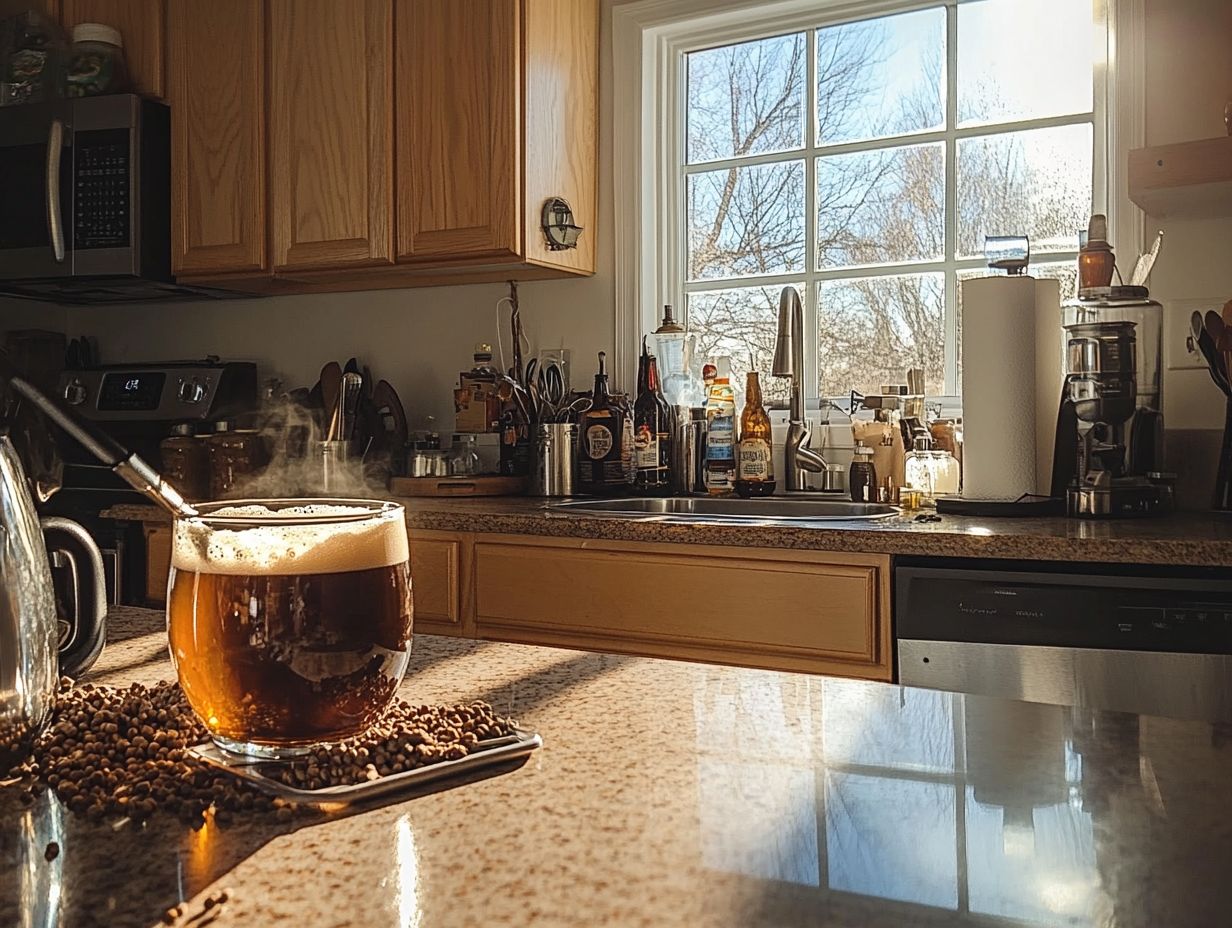
A homebrew porter recipe is a set of instructions for making a dark, malty beer at home using various ingredients and equipment. This beer style originated in the 18th century and includes traditional elements like malt extract and specialty grains.
What are the key ingredients in a homebrew porter recipe?
- Malted barley
- Hops
- Water
- Yeast
- Specialty grains (such as Black Patent Malt, Brown Malt, and Amber Malt)
- Spices and flavorings for unique flavors
Do I need any special equipment to make a homebrew porter recipe?
Yes, you will need some basic homebrewing equipment such as a large pot, fermenter, airlock, and bottling equipment. You can purchase these items at a homebrew supply store or online. Reputable suppliers like Clawhammer Supply offer quality gear for home brewing.
How can I perfect my homebrew porter recipe?
To perfect your homebrew porter recipe, start by taking detailed notes of each batch you make and adjusting the recipe as needed. Experiment with different ingredients and brewing techniques to find what works best for your taste. Leveraging the guidance of experts like Ray Daniels can also provide valuable brewing tips.
How long does it take to make a homebrew porter?
The total time it takes to make a homebrew porter can vary, but on average, it takes about 4-6 weeks. This includes the time for fermentation, bottling, and conditioning the beer. Key factors include fermentation temperature and gravity readings.
Can I customize a homebrew porter recipe to my own taste?
Yes, you can customize a homebrew porter recipe by adjusting the amount of malt, hops, and specialty grains used. You can also add different flavors such as chocolate, coffee, or fruits to create a unique and personalized brew. Hops flavor can be enhanced using varieties like Fuggle or Columbus Hops.
Start brewing your own porter today!


